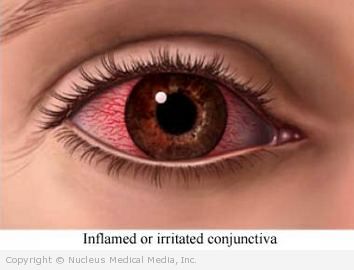Conjunctivitis
(Pink Eye)
Conjunctivitis – Definition
Conjunctivitis is inflammation of the conjunctiva. The conjunctiva is a membrane that covers the eye and lines the inner surface of the eyelid. There are many causes of conjunctivitis.
Conjunctivitis – Causes
Causes include:
- Viral infection
- Bacterial infection, such as staphylococcus or streptococcus
- Allergic reaction, usually related to seasonal allergies
- Chemical irritation caused by:
- Air pollutants
- Soap
- Smoke
- Chlorine
- Make-up
- Other chemicals
Both viral and bacterial conjunctivitis are highly contagious.
Conjunctivitis – Risk Factors
A risk factor is something that increases your chance of getting a disease or condition.
Risk factors for conjunctivitis include:
- Contact with a person who has conjunctivitis
- Sharing towels, linens, or other objects (even doorknobs) with an infected person
- Exposure to chemical or environmental irritants
- Contact lenses, particularly if not maintained properly
- Age: more common in children
- Seasonal allergies or contact with known allergens
Conjunctivitis – Symptoms
Symptoms include:
- Red, watery eyes
- Inflamed inner eyelids
- Scratchy feeling in the eyes
- Itchy eyes
- Pus-like or watery discharge
- Sensitivity to light
- Swelling of the eyelid
Depending on its cause, conjunctivitis will usually clear up within 2-14 days. If conjunctivitis is caused by a seasonal allergy, it may continue to occur throughout the season. If it is caused by a non-seasonal allergy, it may continue to occur year round.
Note: These symptoms can sometimes indicate a more serious medical problem. If you develop these or any other symptoms, see an eye doctor immediately.
Conjunctivitis – Diagnosis
The doctor will ask about your symptoms and medical history. The doctor will examine your eye. If there is discharge from your eye, it may be tested to determine the cause of the conjunctivitis.
Conjunctivitis – Treatment
Treatment will depend on the cause of the conjunctivitis.
Bacterial Infection
Antibiotic eye drops and/or ointment may be prescribed. This will help shorten the course of the infection and the time it is contagious. Wipe away any discharge that accumulates with a clean cotton ball before applying the medication.
Viral Infection
There is no medicine to cure a viral infection. However, many doctors will prescribe topical antibiotics if they cannot rule out the possibility of a bacterial infection. Applying warm compresses or artificial tears (found in pharmacies) may help relieve symptoms. Your eye doctor may also prescribe an anti-inflammatory drop, which may help alleviate your symptoms.
Allergic or Chemical Irritation
Avoid the cause of the irritation (eg, smoke, pollen, make-up). Apply cool compresses to the affected area. Your doctor may prescribe allergy eye drops to help relieve allergic conjunctivitis.
To Prevent Further Spread of Infection
- Keep hands away from your face and do not rub your eyes.
- Change pillowcases and towels every night.
- Do not share pillows or towels.
- Wash hands frequently.
- Avoid shaking hands with others.
- Avoid swimming.
- Carefully clean away any discharge with warm water and clean cotton (or gauze) and immediately discard.
If you are diagnosed with conjunctivitis, follow your doctor’s instructions.
Conjunctivitis – Prevention
Strategies to avoid conjunctivitis include:
- Do not share makeup or eye drops with anyone else.
- Avoid sharing towels, washcloths, pillows, and handkerchiefs,
- Wash hands frequently and keep hands away from eyes,
- Wear watertight goggles when swimming.
- Clean contact lenses daily and never sleep with them unless approved by your eye doctor.
- In case of allergic conjunctivitis, avoid irritants and place allergy-proof covers on your pillows and mattress.
- Your eye doctor can discuss other methods to prevent conjunctivitis, depending on the cause.

